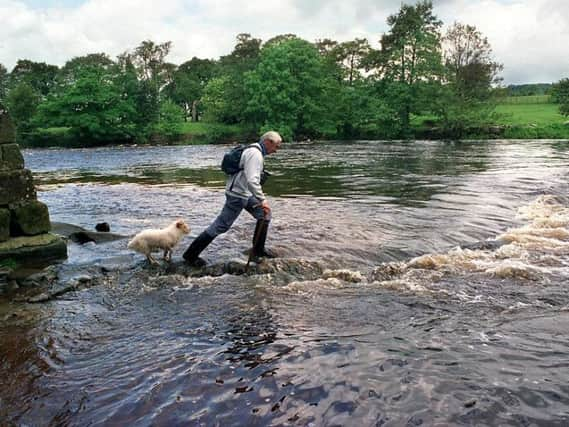Why building bridges is so good for the Yorkshire countryside


There is an ancient crossing of the river north of the village which allows the people of the village access to their riverside. For generations people have crossed the ford and stepping stones to enjoy a picnic or a sunny afternoon.
Once across the river, a network of beautiful footpaths and bridleways leads into stunning lovely Dales countryside, over Askwith and Denton Moors into the Washburn Valley, Nidderdale or further up Wharfedale.
Advertisement
Hide AdAdvertisement
Hide AdBut the river crossing is a barrier. Stepping stones can often be covered. On several occasions, people have been drowned. Heavy rainfall causes the river to rise with alarming speed.
The real danger is that people returning home get caught on the other side, and rather than a six-mile alternative walk home, there is a great temptation to risk a 25 yard crossing of the stones. Children are at particular risk. It is a major local Health and Safety issue.
But for well over a hundred years attempts to replace the dangerous stepping stones with a simple footbridge have been thwarted. Unbelievably, the main reason for this has been constant opposition from a small group of farmers and landowners who don’t want more people to cross the river because they believe the peace and quiet of their rural sanctuary is more important than the health and wellbeing of the 7,000 people who live at the other side of the river.
Current plans for a bridge are blocked by trenchant opposition which belongs to an autocratic era of previous centuries. Yet, with obesity now at epidemic levels, the importance of regular fresh air and exercise in green space has never been more vital.
Advertisement
Hide AdAdvertisement
Hide AdBut change to life even in rural North Yorkshire may soon be on its way. Whether we have Hard or Soft Brexit, agricultural subsidies based on acreage paid to farmers and landowners through the EU Common Agricultural Policy end in less than two years.
The new Environment Secretary, Michael Gove, has indicated that that any future support from the UK Government will be linked to public benefit outcomes – both nature conservation and public access on well-maintained footpaths and bridleways.
Faced with massive demands on the public purse, support for hill farmers may not be the top priority for scarce post-Brexit Government funds.
There is another risk – 75 per cent of British lamb is currently exported to countries within the EU. Beef is another major UK export. But at the same time reduced tariff barriers outside the
Advertisement
Hide AdAdvertisement
Hide AdEU will also allow mass-produced cheap American beef, chicken and pork and New Zealand lamb to flood the UK market.
To survive many farming businesses will have to diversify – perhaps producing more high value crops such as fruit, salad and vegetables, or even specialised new crops.
To give one extraordinary example: recent research has discovered that a drug known as galantamine which is found in both snowdrops and daffodils is capable of combating one of the major scourges of our time, Alzheimer’s disease. Particular species of daffodils grown in tough conditions such as moorland hillsides can produce this.
This is now taking place on a hill farm in Wales, where demand outstrips supply. If it can be grown there, it can be grown in the Yorkshire Dales. This is the kind of new thinking needed.
Advertisement
Hide AdAdvertisement
Hide AdThe image of the farmer with a shotgun and hostile notices, or the antics north of the River Wharfe, are damaging to the image of farming at a time when our farmers need public support more than ever. That goodwill exists, nowhere more so than among the walkers and cyclists who would be regular users of the footbridge.
Far from regarding their fellow citizens as a nuisance to be kept away, local farmers should see people from the other side of the river as potential customers, with money to spend – on afternoon teas, local cheese, lamb, beef, sausages, cakes, flowers or herbs.
When local walkers put on a farm visit during the recent Burley Summer Festival, it was sold out within days. A charge of £5 a head for a couple of hours on a farm learning about rural life is very acceptable, and a perfect opportunity to teach urban communities about rural life.
There could even be opportunities to get local voluntary groups involved in tree planting, pond or other wildlife habitat creation projects. Wildlife needs protection – but it also has high economic value in that it attracts visitors with spending power.
Advertisement
Hide AdAdvertisement
Hide AdVisitors are voters, If the farming community wants to get the political support it needs, it needs to be wooing its public. Rather than resisting people who wish to walk on their land, a welcoming noticeboard at the end of the new bridge – when it is finally built – should tell people where they can walk, get afternoon tea, where the farm shop is, where they can stay in a farmhouse or bunkhouse barn, and directions to the local pub threatened with closure through lack of visitors.
British people – and Yorkshire people in particular – love their countryside. Walkers are natural allies of the farming community. Barriers are damaging and counterproductive. Bunkers don’t protect, but ultimately destroy. Food production and conservation are not contradictory. If, post-Brexit, we can create a more diverse countryside, this can only support the farming community.
For the good of the countryside, at a time of unprecedented change, what we need to do, figuratively as well as is literally, is to build more bridges between our urban and our rural communities.
Colin Speakman is a writer and countryside campaigner. He is also vice president of the Yorkshire Dales Society.